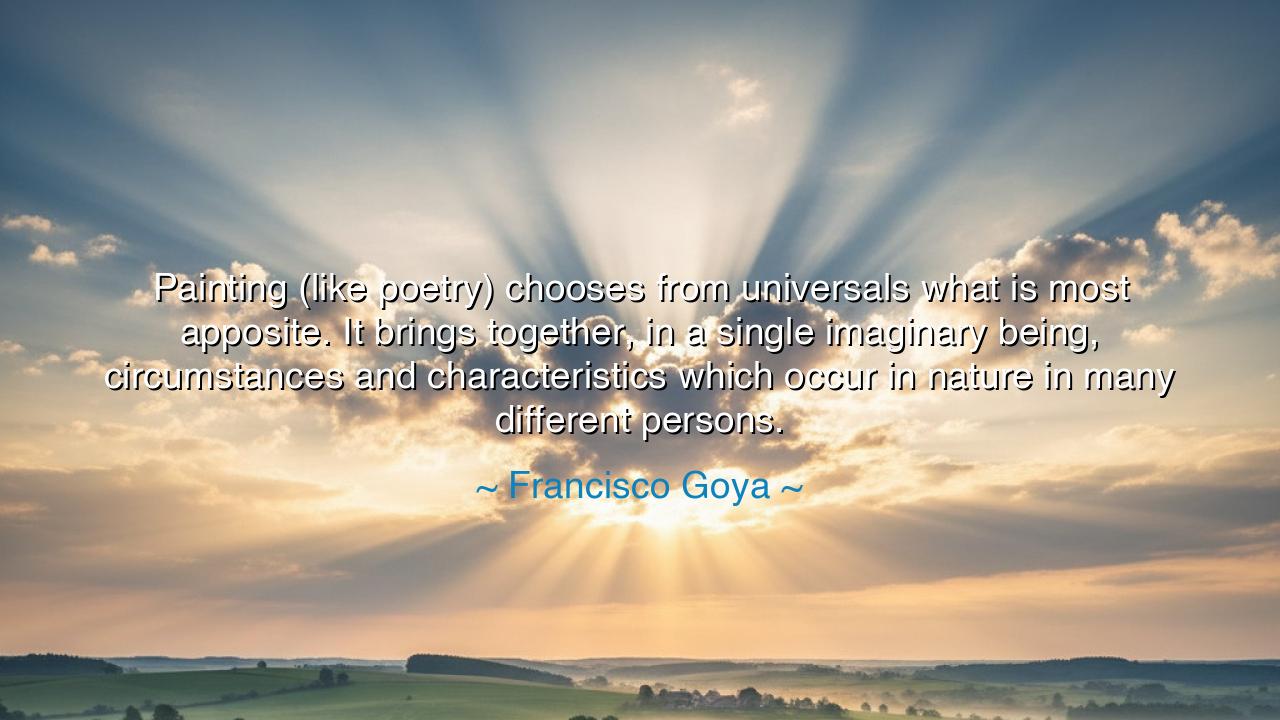
Painting (like poetry) chooses from universals what is most
Painting (like poetry) chooses from universals what is most apposite. It brings together, in a single imaginary being, circumstances and characteristics which occur in nature in many different persons.






Francisco Goya, painter of both kings and nightmares, once revealed a profound truth: “Painting (like poetry) chooses from universals what is most apposite. It brings together, in a single imaginary being, circumstances and characteristics which occur in nature in many different persons.” These words are not a casual remark but a revelation of the artist’s ancient task: to distill the essence of life, to gather fragments scattered among many souls, and to shape them into one form that carries the weight of the universal.
When Goya speaks of painting and poetry, he places them side by side as twin arts of vision. Both do not merely record the world as it is, but lift from it what is most essential, most true, and most resonant. The poet does not copy conversation but weaves phrases that capture the eternal rhythm of the human heart. The painter does not reproduce a single face exactly as it appears but gathers from many faces the traits that reveal a deeper truth. Thus, the portrait of an imaginary being may be truer than the likeness of any one man, for it embodies the essence of many.
The ancients understood this well. Aristotle, in his Poetics, declared that poetry is “more philosophical and more serious than history,” because history tells what happened, but poetry tells what could or should happen. Goya echoes this: painting, like poetry, transcends the particular to reveal the universal. When he painted his haunting images of war in The Disasters of War, he did not capture a single soldier’s cruelty or a single victim’s suffering; he condensed the anguish of multitudes into single, unforgettable images. The horror became universal, not anecdotal, and in this way, the art spoke for all humanity.
History gives us further proof in the work of Michelangelo. His David is not a portrait of any one man but a composite of the ideals of courage, youth, and divine beauty. In that statue, we see not the body of a Florentine citizen but the spirit of defiance itself, carved into stone. So too with Homer’s Achilles or Shakespeare’s Hamlet: neither is drawn from one life, but each gathers the struggles, doubts, and passions of countless men. They are imaginary beings, yet they embody truths more lasting than the lives of their creators.
There is a heroic depth to Goya’s teaching. He reminds us that the artist’s task is not to flatter reality but to reveal it. A painter who simply copies the world may capture its surfaces, but a painter who selects from universals creates a mirror of the soul. This is why Goya could portray both the grandeur of court and the grotesque of nightmare, for he was not bound to appearances but to the deeper forces moving beneath them. His witches, monsters, and dream-visions are imaginary, yet they reveal more about human fear and folly than any ledger of facts.
The lesson for us, O seekers, is this: if we wish to create, we must learn to see beyond the surface. Do not be content to describe or depict as things appear, but ask: What essence lies here? What universal truth can I reveal? Whether in art, in writing, or in daily speech, strive to choose what is most apposite, most fitting to the human condition. Let your words and works be more than record-keeping; let them gather the scattered fragments of truth and fuse them into one vision that speaks across generations.
Practical action follows. If you are a writer, read widely—not to imitate, but to discern the common threads of humanity, then weave them into your tales. If you are an artist, observe many faces, many gestures, many postures, and from them form a single image that embodies the essence of all. If you are neither poet nor painter, still you can practice this in life: when you see your fellow man, seek the universal in him—the courage, the fear, the love, the weakness—that binds all souls together.
Thus Goya’s words shine not only as an artist’s insight but as eternal wisdom. “Painting (like poetry) chooses from universals what is most apposite… It brings together, in a single imaginary being, circumstances and characteristics which occur in nature in many different persons.” Let us then honor the task of creation, not to copy what passes, but to reveal what endures. For in the work of the true artist, the particular becomes universal, and the fleeting becomes eternal.






AAdministratorAdministrator
Welcome, honored guests. Please leave a comment, we will respond soon